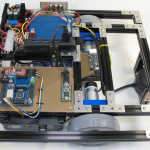Hier sind Erfahrungen mit der Installation von ROS-Fuerte auf einem Raspberry Pi Modell B mit 512MByte Arbeitsspeicher. Eine Installationsanleitung auf www.ros.org für ROS-Fuerte auf einem Raspberry Pi war zu der Zeit nicht verfügbar. Die Installation basiert auf der Anleitung für Debian-Systeme. Ein grober Fehler, der passiert ist, war das Überspringen eines gesamten Installationsschrittes. Trotzdem habe ich das Installations-Protokoll nicht korrigiert, denn Fehler passieren, und es ist trotzdem möglich, ein ROS-Desktop (ohne rviz, PCL) + ffmpeg0.6.6 + OpenCV 2.4.3 auf einen Raspberry Pi zu kompilieren. Die Gesamt-Installation und -Konfiguration dauert Tage…
Raspberry Pi – Betriebssystem
Auf eine 16GB-Micro-SD-Karte wird das Image: 2012-10-28-wheezy-raspbian.img installiert – dd (Linux), Win32 Disk Imager (Windows).
Siehe auch Installationsanleitung hier.
SECURITY:
Autologout 30 min.
vi /etc/profile
TMOUT=1800
Root-Login mit ssh nicht erlaubt.
vi /etc/ssh/sshd_config PermitRootLogin no
VNC über SSH tunneln.
Voraussetzungen:
1. RaspberryPi:
Software: sshd, vncserver
>> vncserver :1 (Startet VNCServer auf Port 5901)
2. Client-PC (Windows):
Software: PuTTY, tightVNC-Viewer
-PuTTY starten
-Konfiguration Session:
Host Name (or IP address) = raspberrypi Port = 22
-Konfiguration Connection -> SSH -> Tunnels -> Port forwarding
Source port = 5901 Destination = 127.0.0.1:5901
Add-Button drücken.
Ohne PuTTY sieht der Connection-String so aus:
ssh -L 5901:127.0.0.1:5901 raspberrypi
Open-Button drücken.
TightVNC-Viewer starten
VNCServer = 127.0.0.1:5901
Connect-Button drücken.
In Wireshark oder tcpdump sollten dann keine VNC-Pakete mehr erscheinen, stattdessen SSH. Empfehlenswert ist auch die strikte Verwendung von SSHv2-Protokoll.
Client:
PuTTY -> Connection -> SSH -> Protocol options -> 2only
Server:
/etc/ssh/sshd_config -> Protocol 2
KONFIGURATION:
Raspberry Pi muss übertaktet werden (High 950 MHz), da sonst die Kompilierungszeit zu groß wird.
sudo raspi-config
Farbige Konsole für root.
vi /root/.bashrc PS1='e[1;31;40mu@h:w # e[0m'
Der Arbotix-Controller macht Probleme auf nicht US-Systemen.
dpkg-reconfigure locales
en_US.UTF-8 auswählen.
Allgemein
Aktuelles Datum setzen, zum Beispiel: 06.12.2012 14:31
date 120614312012
Serielle Schnittstelle (Rechte):
groupmod -a -G dialout rosuser
Webcam (Rechte):
groupmod -a -G video rosuser
SWAP (empfohlen während Install, 900MB):
sudo swapoff -a sudo dd if=/dev/zero of=/var/myswap bs=1024 count=900k sync sudo mkswap /var/myswap sudo swapon /var/myswap vi /etc/fstab /var/myswap swap swap defaults 0 0
ROS-Fuerte
INSTALL:
1.1
1.
sudo apt-get install build-essential python-yaml cmake subversion wget python-setuptools mercurial git-core
2. (Zu installierende Pakete übersehen, siehe Fehler bei 1.3.1)
sudo apt-get install python-yaml libapr1-dev libaprutil1-dev libbz2-dev python-dev libgtest-dev python-paramiko libboost-all-dev liblog4cxx10-dev pkg-config python-empy swig
3.
sudo apt-get install python-nose
4. (Optional graphical tools ‚ROS Full‘)
sudo apt-get install python-wxgtk2.8 python-gtk2 python-matplotlib libwxgtk2.8-dev python-imaging libqt4-dev graphviz qt4-qmake python-numpy
5.
sudo apt-get install bison++ automake autoconf git clone https://github.com/wg-debs/swig-wx.git cd swig-wx ./autogen.sh && ./configure && make && sudo make install
1.2 US-Amerikanisches Tastaturlayout einstellen
Der Arbotix-Controller macht Probleme mit anderen Sprachen, deshalb en_US.UTF-8.
sudo dpkg-reconfigure locales
=> en_US.UTF-8
Spielt keine Rolle wenn per Putty eingeloggt wird, da in Putty konfigurierbar ist, wie sich die Tastatur verhalten soll.
1.3
1. rosinstall
sudo apt-get install python-rosinstall
ODER (IF the above fails…)
sudo apt-get install python-pip sudo pip install -U rosinstall
2. rospkg
sudo pip install -U rospkg
3. rosdep
sudo pip install -U rosdep sudo rosdep init sudo rosdep update
1.3.1
Download/Update ROS-Libs:
Full:
rosinstall --catkin ~/ros-underlay http://ros.org/rosinstalls/fuerte-ros-full.rosinstall
Fehler:
ERROR in config: Error processing ‚actionlib‘ : [actionlib] Checkout of git: No such file…
Siehe: http://answers.ros.org/question/46848/installing-ros-from-source-actionlib-error/
Lösung: Textdatei „fuerte-ros-full.rosinstall“ anpassen:
a. Download: http://ros.org/rosinstalls/fuerte-ros-full.rosinstall
b. Öffnen: vi Download/fuerte-ros-full.rosinstall
c. Ändern: wg-debs = ros-gbp
d. Ausführen: sudo rosinstall –catkin ~/ros-underlay file:///Pfad_zu/fuerte-ros-full.rosinstall
Build:
cd ~/ros-underlay
mkdir build
cd build
cmake .. -DCMAKE_INSTALL_PREFIX=/opt/ros/fuerte
Fehler:
— Could NOT find PY_em (missing: PY_EM)
CMake Error at catkin/cmake/empy.cmake:29 (message):
Unable to find either executable ‚empy‘ or Python module ‚em’…
try installing package ‚python-empy‘
Call Stack (most recent call first):
catkin/cmake/all.cmake:51 (include)
catkin/CMakeLists.txt:12 (include)
Lösung:
sudo apt-get install python-empy
Fehler:
GTest not found
Lösung:
sudo apt-get install libgtest-dev
Fehler:
Couldn’t find Boost
1. Installiert libboost-dev
2. Deinstalliert libboost-dev
3. Installiert libboost-all-dev
Lösung:
sudo apt-get install libboost-all-dev
Fehler: libboost-all-dev = 1.49 wird von ROS Fuerte nicht unterstützt
Lösung: verwende libboost1.46-all-dev
Fehler:
Couldn’t find log4cxx library
Lösung:
apt-get install liblog4cxx10-dev
Fehler:
Could NOT find BZip2 (missing: BZIP2_LIBRARIES BZIP2_INCLUDE_DIR)
Lösung:
apt-get install libbz2-dev
Make ROS
make -j8
Fehler:
…
Lösung:
make -j1
export ROS_OS_OVERRIDE=debian:squeeze
(in ~/.profile eintragen!!!)
. /opt/ros/fuerte/setup.bash
rosinstall ~/ros "http://packages.ros.org/cgi-bin/gen_rosinstall.py?rosdistro=fuerte&variant=desktop-full&overlay=no"
turtle.cpp AUSTAUSCHEN mit turtle.txt
1.5
rosdep install -ay --os=debian:squeeze
Schritt 1.5 hat NICHT GEKLAPPT!!!
Arbotix-Controller
Der Arbotix-Controller wird mit dem Raspberry PI über einen FTDI-Schnittstellenadapter von SparkFun verbunden. Am Arbotix-Controller-Board sind drei Dynamixel-Ports vorhanden, an denen (aktuell) zwei AX12+-Motoren hängen. Am Ende sollen die Positionen der Motoren abgefragt und gesetzt werden.
Voraussetzung: Arbotix-ROS wurde auf den Arbotix-Controller übertragen. Im Ordner ..Arbotix_Firmwarearbotix_firmwaresrc befindet sich die Arduino-Datei „ros.ino„.
Arbotix Firmware
roscd svn http://vanadium-ros-pkg.googlecode.com/svn/trunk/arbotix
Abhängigkeiten
Siehe: ~/ros-workspace/arbotix/arbotix_python/nodes/manifest.xml, …/arbotix/rosdep.yaml
Stack: control
Package: control_msgs
APT: python-serial
roscd roslocate info control roslocate info control | rosws merge - rosws update control roslocate info control source setup.bash roslocate info arbotix roslocate info arbotix | rosws merge - rosws update source setup.bash rospack list
rosmake:
rosmake arbotix_python rosmake arbotix_msgs
FEHLER:
arbotix import serial error: no module named serial
LÖSUNG (siehe auch ~/ros-workspace/arbotix/arbotix_python/nodes/manifest.xml):
sudo apt-get install python-serial
rosmake nach Fehlerbehebung:
rosmake arbotix_python rosmake arbotix_msgs
SETUP/START
source /opt/ros/fuerte/setup.bash rosrun arbotix_python terminal.py >> ls .... .... .... 4 5 6 .... .... .... .... .... .... .... .... .... .... .... .... >> ls .... .... 3 4 5 6 .... .... .... .... .... .... .... .... .... .... .... .... >> get pos 3 358 >> set pos 3 500 OK >> get pos 5 314 >> set pos 5 400 OKremote shell(ssh) into Raspberry PI controlling
humanoid via arbotix-controller.
usb_cam
Die Treiber von Bosch haben nicht zuverlässig auf dem Raspberry PI gearbeitet. Teilweise lag es an der schlechten Kamera und deren Bildrate. Am Ende hat es mit den gscam-Treibern am Besten funktioniert. Deshalb kann ich die Verwendung von usb_cam auf einem Raspberry PI nicht empfehlen.
Logitech QuickCam E2500 VGA with Bosch-Drivers
Quellennachweis:
http://www.ros.org/wiki/usb_cam
Abhängigkeiten
manifest.xml
1. Installation
roscd roslocate info usb_cam roslocate info usb_cam| rosws merge - rosws update source setup.bash rosmake usb_cam
FEHLER:
error: no module named pluginlib
LÖSUNG:
roslocate info pluginlib roslocate info pluginlib| rosws merge - rosws update source setup.bash rosmake pluginlib rosmake usb_cam
FEHLER:
error: no module named tinyxml
FEHLER:
_ssl.c:504: error:14090086:SSL routines:SSL3_GET_SERVER_CERTIFICATE:certificate verify failed
LÖSUNG:
sudo apt-get install libavcodec-dev sudo apt-get install libswscale-dev sudo apt-get install libtinyxml-dev rosmake usb_cam
FEHLER:
ros libusb_cam.so: undefined reference to `avcodec_decode_video‘
LÖSUNG:
sudo apt-get remove --purge libavcodec-dev sudo apt-get install libavcodec-dev rosmake --pre-clean usb_cam roscore & rosrun usb_cam usb_cam_node
FEHLER:
rosrun usb_cam usb_cam_node
usb_cam video_device set to [/dev/video0]
usb_cam io_method set to [mmap]
usb_cam image_width set to [640]
usb_cam image_height set to [480]
usb_cam pixel_format set to [mjpeg]
usb_cam auto_focus set to [0]
[mjpeg @ 0xd658e0] codec type or id mismatches
Could not open MJPEG Decoder
Segmentation fault
LÖSUNG: ???
1.1 Video-Rechte
usermod -a -G video benutzername
1.2 Testing usb_cam on RaspberryPi :: wheezy
roscore rosrun usb_cam usb_cam_node
FEHLER:
Webcam: expected picture but didn’t get it…
11 frames/sec at 1359486887.849637453
Webcam: expected picture but didn’t get it…
Webcam: expected picture but didn’t get it…
LÖSUNG:
siehe 5 : usbCam.launch
1.3 Tutorial OpenCV – USBCam
1. Erstelle eigenes Paket
roscreate-pkg tutorial_rosopencv_mc image_transport roscpp std_msgs opencv2 cv_bridge usb_cam arbotix_msgs arbotix_python
2. Absteigen in Paketordner
cd tutorial_rosopencv_mc
3. Launch-Datei Ordner erstellen
mkdir launch
4. Absteigen in Launch-Ordner
cd launch
5. Launch-Datei erstellen
vi usbCam.launch <!--xml--> <launch> <node ns="camera" pkg="usb_cam" type="usb_cam_node" name="usb_cam" output="screen"> <param name="image_width" type="int" value="320" /> <param name="image_height" type="int" value="240" /> <param name="io_method" type="string" value="read" /> <param name="camera_frame_id" type="string" value="webcam" /> <param name="video_device" type="string" value="/dev/video0" /> <param name="pixel_format" type="string" value="yuyv" /> </node> //* TEST <node name="image_view" pkg="image_view" type="image_view" respawn="false" output="screen"> <remap from="image" to="/usb_cam/image_raw"/> <param name="autosize" value="true" /> </node> *// </launch>
6. ROS_PACKAGE_PATH
vi ~/.bashrc
Am Ende:
export ROS_PACKAGE_PATH=$ROS_PACKAGE_PATH:~/ros/tutorial_rosopencv_mc source ~/ros/setup.bash
7. rosmake
rosmake tutorial_rosopencv_mc
FEHLER:
opencv not found
Lösung:
opencv installieren
OpenCV
02.02.2013 19:00
1 Installation
1.1 Systemvoraussetzung:
-Raspberry PI Model B (512MB RAM) mit Debian wheezy
-folgende Programme und Bibliotheken
Basierend auf der Installationsanleitung für Debian-Systeme.
Quellennachweis:
http://opencv.willowgarage.com/wiki/InstallGuide%20:%20Debian
http://www.ros.org/wiki/ROSberryPi/Setting%20up%20ROS%20on%20RaspberryPi
apt-get install build-essential apt-get install cmake apt-get install pkg-config apt-get install libpng12-0 libpng12-dev libpng++-dev libpng3 apt-get install libpnglite-dev libpngwriter0-dev libpngwriter0c2 (PNG-Output-Support) apt-get install zlib1g-dbg zlib1g zlib1g-dev apt-get install libjasper-dev libjasper-runtime libjasper1 apt-get install pngtools libtiff4-dev libtiff4 libtiffxx0c2 libtiff-tools apt-get install libjpeg8 libjpeg8-dev libjpeg8-dbg libjpeg-progs apt-get install ffmpeg libavcodec-dev libavcodec53 libavformat53 libavformat-dev apt-get install libgstreamer0.10-0-dbg libgstreamer0.10-0 libgstreamer0.10-dev apt-get install libxine1-ffmpeg libxine-dev libxine1-bin apt-get install libunicap2 libunicap2-dev apt-get install libdc1394-22-dev libdc1394-22 libdc1394-utils apt-get install swig apt-get install libv4l-0 libv4l-dev apt-get install python-numpy apt-get install libpython2.7 python-dev python2.7-dev apt-get install libgtk2.0-dev pkg-config apt-get install libgstreamer-plugins-base0.10-dev
Bugs:
http://raspberrypi.stackexchange.com/questions/1888/error-in-installing-opencv-on-raspberry-pi
1.2 Download OpenCV-2.4.3:
wget http://sourceforge.net/projects/opencvlibrary/files/opencv-unix/2.3.1/OpenCV-2.3.1a.tar.bz2 wget http://sourceforge.net/projects/opencvlibrary/files/opencv-unix/2.4.3/OpenCV-2.4.3.tar.bz2
1.3 Extrahieren, Compiler-Ordner erstellen
tar xvf OpenCV-2.4.3.tar.bz2 cd OpenCV-2.4.3 mkdir build cd build cmake -D CMAKE_BUILD_TYPE=RELEASE -D CMAKE_INSTALL_PREFIX=/usr/local -D BUILD_PYTHON_SUPPORT=ON -D BUILD_EXAMPLES=ON ..
1.4 Kompilieren
make
FEHLER:
make[2]: *** [modules/highgui/CMakeFiles/opencv_highgui.dir/src/cap_ffmpeg.o] Error 1
make[1]: *** [modules/highgui/CMakeFiles/opencv_highgui.dir/all] Error 2
LÖSUNG:
ffmpeg installieren! Siehe ffmpeg
make
FEHLER:
(Segmentation Fault -> Arbeitsspeicher-Problem):
/home/beeper/Download/OpenCV-2.4.3/modules/highgui/src/window.cpp: In function ‘double cvGetWindowProperty(const char*, int)’:
/home/beeper/Download/OpenCV-2.4.3/modules/highgui/src/window.cpp:153:1: internal compiler error: Segmentation fault
Please submit a full bug report,
with preprocessed source if appropriate.
See <file:///usr/share/doc/gcc-4.6/README.Bugs> for instructions.
The bug is not reproducible, so it is likely a hardware or OS problem.
make[2]: *** [modules/highgui/CMakeFiles/opencv_highgui.dir/src/window.cpp.o] Error 1
make[1]: *** [modules/highgui/CMakeFiles/opencv_highgui.dir/all] Error 2
make: *** [all] Error 2
LÖSUNG:
Memory und CPU/GPU auf normale Geschwindigkeit setzen
raspi-config -> Overclocking -> Normal oder Medium (Dauer ca. 9h) raspi-config -> Memory -> GPU=32 (vorher 64) make
Ca. 9 Stunden später…
sudo make install
1.5 Konfiguration OpenCV
sudo vi /etc/ld.so.conf.d/opencv.conf /usr/local/lib sudo ldconfig
ffmpeg
03.02.2013 14:34falls ffmpeg zuvor installiert war:
sudo apt-get remove --purge ffmpeg sudo apt-get remove libavcodec53
1. Installation
1.1 Systembibliotheken
MP3, Ogg-Theora, Ogg-Vorbis, V4L, H.264, MPEG-4:
sudo apt-get install libmp3lame-dev sudo apt-get install libtheora-dev sudo apt-get install libvorbis-dev sudo apt-get install libv4l-dev sudo apt-get install libvpx-dev sudo apt-get install libx264-dev sudo apt-get install libxvidcore-dev
1.2 Download ffmpeg
0.6.6 läuft mit libavcodec52 (VORHER ffmpeg + libavcodec53 deinstallieren)
wget http://ffmpeg.org/releases/ffmpeg-0.6.6.tar.bz2
ODER die neueste Version verwenden (nicht getestet!).
1.1.1 neueste Version (01/2013)
wget http://ffmpeg.org/releases/ffmpeg-1.1.1.tar.bz2
1. 3 Konfiguration und Kompilation (mehrere Stunden…)
tar xvf ffmpeg-0.6.6.tar.bz2 cd ffmpeg-0.6.6 ./configure --enable-shared --enable-pic --enable-libdc1394 --enable-libmp3lame --enable-libtheora --enable-libvorbis --enable-libv4l2 --enable-libvpx --enable-libxvid --enable-libx264 --enable-gpl make sudo make install sudo ldconfig
(zurück zu OpenCV)
gscam
gstreamer cam
Fehler in CMakeLists.txt während rosmake gscam:
fatal error: glibconfig.h: No such file or directory
Folgende „lib“ in CMakeLists.txt hinzufügen:
/usr/lib/arm-linux-gnueabihf/glib-2.0/include
rosmake gscam
Tutorial:
export GSCAM_CONFIG="v4l2src device=/dev/video0 ! video/x-raw-rgb ! ffmpegcolorspace" roscore & rosrun gscam gscam rosrun image_view image_view image:=/gscam/image_raw






